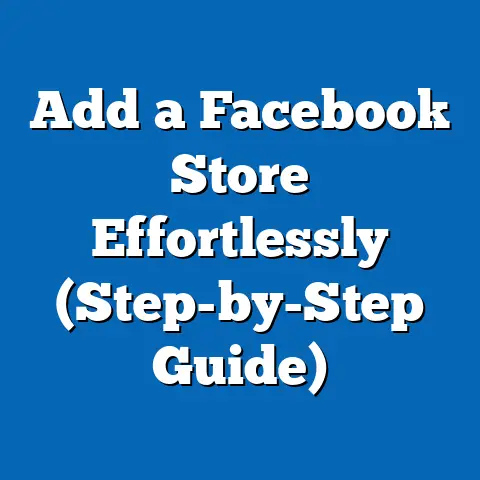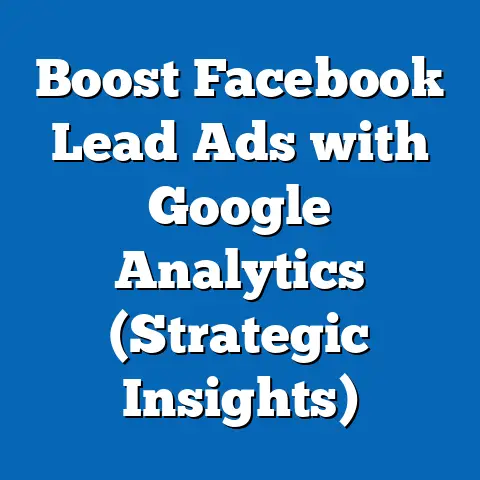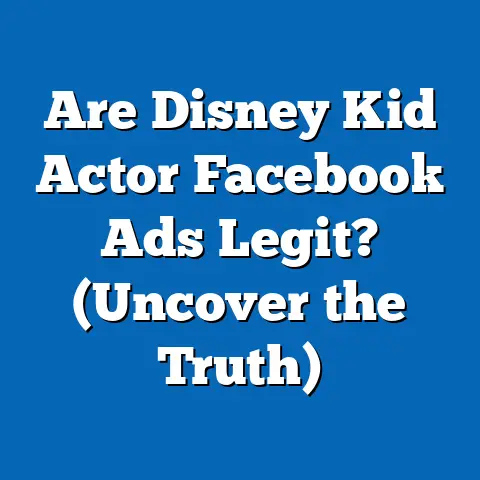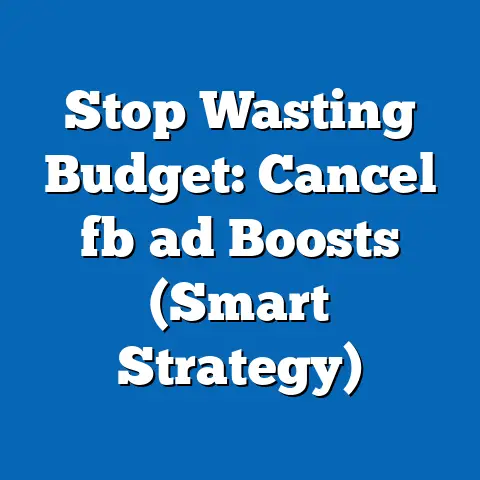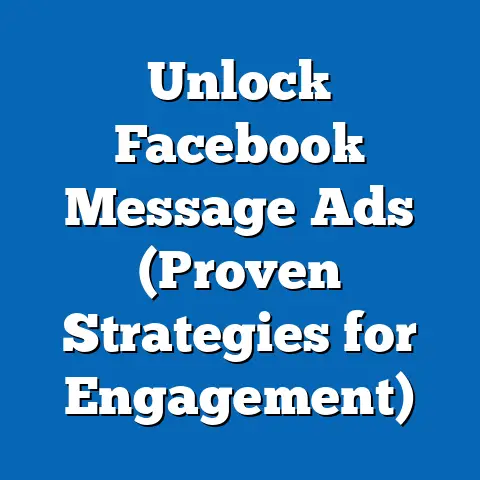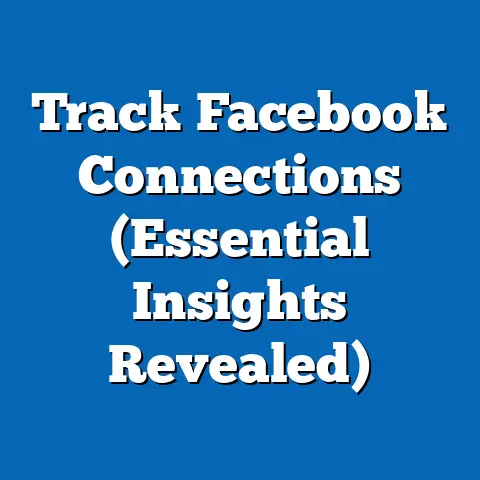Erase Unwanted Facebook Ads (Pro Guide to Ad Control)
In a world where we are constantly bombarded with advertisements, it’s almost comforting to know that we have the power to control our own experiences—unless, of course, you’re scrolling through Facebook. Ah, Facebook ads. Those little squares or videos that seem to know exactly what you were thinking about buying five minutes ago, or worse, remind you of that embarrassing purchase you made last year. The truth is, Facebook ads have become an integral part of the platform, often feeling more like an intrusion than a helpful suggestion. But what if I told you that you’re not entirely powerless? That you can actually take control of the ads you see and tailor your Facebook experience to be less annoying and more relevant?
As a digital marketing specialist, I’ve spent years navigating the ins and outs of Facebook advertising, both from the perspective of a marketer trying to reach the right audience and as a user who just wants to scroll through memes without being constantly reminded of my need for new socks. In this guide, I’m going to share my insights and strategies for effectively managing your ad experience on Facebook. We’ll dive deep into how Facebook targets you, why certain ads are so persistent, and, most importantly, what you can do about it.
This isn’t just about blocking ads entirely (though we’ll touch on that). It’s about understanding the system, leveraging the tools Facebook provides, and making informed choices that give you a more personalized and less intrusive experience. So, if you’re ready to reclaim your Facebook feed, let’s get started!
Section 1: Understanding Facebook Ads
To effectively combat unwanted ads, it’s essential to first understand how Facebook advertising works. Think of it as knowing your enemy before you head into battle. In this section, we’ll explore the evolution of Facebook ads, the mechanics of how Facebook targets you, and the psychology behind why these ads can feel so intrusive.
1.1 The Evolution of Facebook Advertising
Facebook advertising has come a long way since its humble beginnings. Back in the mid-2000s, Facebook ads were simple banner ads, often clunky and ineffective. I remember when I first started using Facebook, these ads were more of a distraction than anything else. They felt like an afterthought, a necessary evil to keep the platform free.
But as Facebook grew, so did its advertising capabilities. The introduction of News Feed ads was a game-changer. These ads were designed to blend seamlessly into the user’s feed, making them less disruptive and more engaging. Over time, Facebook developed sophisticated algorithms to target users based on their demographics, interests, and behaviors.
Today, Facebook advertising is a multi-billion dollar industry, powered by advanced machine learning and vast amounts of user data. From image ads to video ads, carousel ads to lead generation ads, the platform offers a wide range of ad formats and targeting options. It’s a far cry from those simple banner ads of the past, and it’s constantly evolving.
Takeaway: Understanding the evolution of Facebook advertising helps you appreciate the complexity of the system and the sophistication of the targeting methods used today.
1.2 How Facebook Targets You
This is where things get interesting, and sometimes a little unsettling. Facebook’s ability to target users with such precision is what makes it so attractive to advertisers, and so frustrating for users who are bombarded with irrelevant ads.
So, how does Facebook do it? It all starts with data. Facebook collects a massive amount of information about its users, including:
- Demographic Data: Age, gender, location, education, and relationship status.
- Interest Data: Pages you like, groups you join, events you attend, and topics you engage with.
- Behavioral Data: Websites you visit, apps you use, purchases you make, and ads you click on.
- Offline Activity: Data from third-party sources, such as loyalty programs and credit card transactions.
Facebook then uses this data to create detailed user profiles, which are used to target ads to specific audiences. For example, if you frequently visit websites about hiking and outdoor gear, Facebook might show you ads for hiking boots or camping equipment. If you’ve recently searched for flights to Paris, you might see ads for hotels or tours in Paris.
The targeting options are incredibly granular. Advertisers can target users based on their income, their political affiliation, their job title, and even their life events (e.g., recently engaged, recently moved). I’ve seen campaigns that target users who are “likely to move” based on their online behavior – it’s that specific.
Takeaway: Facebook’s targeting capabilities are based on a vast amount of user data, which is used to create detailed profiles and target ads to specific audiences. The more you understand how this data is collected and used, the better equipped you’ll be to control your ad experience.
1.3 The Psychology Behind Ads
Ever wonder why some ads are just so darn annoying? It’s not always about the product or service being advertised; it’s often about the psychology behind the ad itself. Targeted ads can feel intrusive because they remind us that our online activity is being tracked and analyzed. This can lead to feelings of unease or even paranoia.
Repetitive ads can also be incredibly frustrating. Seeing the same ad over and over again can create a sense of annoyance and resentment towards the brand. This is especially true if the ad is for a product or service you’re not interested in.
Furthermore, ads that prey on our insecurities or fears can be particularly damaging. For example, ads that promote weight loss products or financial services can trigger negative emotions and reinforce harmful stereotypes.
As a marketer, I’m always mindful of the psychological impact of my ads. It’s important to create ads that are relevant, engaging, and respectful of the user’s experience. The goal is to provide value, not to annoy or manipulate.
Takeaway: The psychology behind ads plays a significant role in how we perceive them. Understanding these psychological factors can help you recognize and manage your emotional response to unwanted ads.
Section 2: The Problem of Unwanted Ads
Now that we have a better understanding of Facebook advertising, let’s delve into the specific problem of unwanted ads. What exactly constitutes an “unwanted ad”? What are the common frustrations users experience? And how do these ads impact the overall user experience?
2.1 Identifying Unwanted Ads
“Unwanted ads” are subjective, but they generally fall into a few categories:
- Irrelevant Ads: Ads that are completely unrelated to your interests or needs. For example, seeing ads for baby products when you don’t have children.
- Repetitive Ads: Seeing the same ad over and over again, even after you’ve expressed disinterest.
- Misleading Ads: Ads that make false or exaggerated claims about a product or service.
- Offensive Ads: Ads that are discriminatory, hateful, or otherwise offensive.
- Intrusive Ads: Ads that disrupt your browsing experience, such as pop-up ads or autoplay videos.
- Ads for Products/Services You’ve Already Purchased: Seeing ads for something you bought last week is just plain annoying.
I once had a friend who was constantly bombarded with ads for a dating app, even though she was happily married. She found it incredibly frustrating and intrusive. It’s a perfect example of an irrelevant ad that completely missed the mark.
Takeaway: Identifying the specific types of ads you find unwanted is the first step towards taking control of your ad experience.
2.2 Common Frustrations
I’ve spoken to countless Facebook users who have expressed their frustration with unwanted ads. Here are some common themes:
- Feeling Tracked: The feeling that Facebook is constantly watching your every move and using your data against you.
- Loss of Privacy: The concern that your personal information is being shared with advertisers without your consent.
- Annoyance and Irritation: The sheer annoyance of being bombarded with irrelevant or repetitive ads.
- Wasted Time: The time spent scrolling past unwanted ads or trying to hide them.
- Negative Brand Perception: The development of a negative perception of brands that are associated with intrusive or misleading ads.
One user told me, “I feel like I’m being stalked by these ads. It’s creepy and unsettling.” Another said, “I’m so tired of seeing the same ad over and over again. It makes me want to boycott the company.”
These frustrations are valid and understandable. Unwanted ads can significantly detract from the Facebook experience and erode trust in the platform.
Takeaway: Unwanted ads can lead to a range of frustrations, including feeling tracked, loss of privacy, annoyance, wasted time, and negative brand perception.
2.3 The Impact on User Experience
The cumulative effect of unwanted ads can have a significant impact on the user experience. Studies have shown that users who are exposed to a high volume of irrelevant ads are more likely to:
- Spend Less Time on Facebook: They may become less engaged with the platform and spend less time scrolling through their feed.
- Use Facebook Less Frequently: They may start using Facebook less often or even abandon the platform altogether.
- Develop a Negative Perception of Facebook: They may view Facebook as intrusive, annoying, and untrustworthy.
- Be Less Likely to Click on Ads: They may become less receptive to advertising in general and less likely to click on ads, even if they are relevant.
This is bad news for both Facebook and advertisers. If users are turned off by unwanted ads, they’re less likely to engage with the platform and less likely to respond to advertising.
Takeaway: Unwanted ads can negatively impact the user experience, leading to decreased engagement, negative perception of Facebook, and reduced ad effectiveness.
Let’s get to the solutions. In this section, we’ll explore the various tools and techniques you can use to control the ads you see on Facebook.3.1 Adjusting Ad Preferences
One of the most effective ways to control your ad experience is to adjust your ad preferences. Facebook allows you to customize your interests, demographics, and other targeting options, which can significantly reduce the number of irrelevant ads you see.
Here’s a step-by-step guide on how to access and modify your ad preferences:
- Go to Your Facebook Settings: Click on the down arrow in the top right corner of your Facebook page and select “Settings & Privacy,” then click “Settings.”
- Navigate to Ad Preferences: In the left-hand menu, click on “Ads.”
- Explore Your Interests: Here, you’ll see a list of your interests, which Facebook has inferred based on your activity on the platform. You can remove interests that are inaccurate or irrelevant by clicking on the “X” next to each interest.
- Review Advertisers You’ve Interacted With: This section shows a list of advertisers whose ads you’ve clicked on or engaged with. You can choose to hide ads from specific advertisers by clicking on the three dots next to their name and selecting “Hide Ads.”
- Manage Ad Settings: This section allows you to control how Facebook uses your data for advertising purposes. You can limit the use of data from partners, turn off location tracking, and manage other privacy settings.
I recommend regularly reviewing and updating your ad preferences to ensure they accurately reflect your interests and needs. It’s a simple but effective way to improve your ad experience.
Takeaway: Adjusting your ad preferences is a powerful way to control the ads you see on Facebook. Regularly review and update your interests, advertisers you’ve interacted with, and ad settings to improve your ad experience.
3.2 Hiding and Reporting Ads
Another way to control your ad experience is to hide and report ads that are irrelevant or annoying. This sends a signal to Facebook that you’re not interested in the ad, which can help to reduce the number of similar ads you see in the future.
Here’s how to hide and report ads on Facebook:
- Click on the Three Dots: When you see an ad in your News Feed, click on the three dots in the top right corner of the ad.
- Select “Hide Ad”: This will hide the ad from your feed and give you the option to provide feedback on why you’re hiding it.
- Choose a Reason: Select the reason that best describes why you’re hiding the ad, such as “It’s not relevant to me” or “I see this ad too often.”
- Report the Ad (If Necessary): If the ad is misleading, offensive, or violates Facebook’s advertising policies, you can report it by selecting “Report Ad.”
Reporting ads is especially important if you encounter ads that are discriminatory, hateful, or otherwise harmful. Facebook takes these reports seriously and will investigate the ad to determine whether it violates its policies.
Takeaway: Hiding and reporting ads is a simple but effective way to signal to Facebook that you’re not interested in certain types of ads. Reporting ads that violate Facebook’s policies helps to keep the platform safe and respectful.
3.3 Utilizing Third-Party Tools
In addition to Facebook’s built-in ad controls, there are also a number of third-party tools that can help you block or filter unwanted ads. These tools typically come in the form of browser extensions or apps that can be installed on your computer or mobile device.
Some popular ad-blocking tools include:
- AdBlock: A widely used browser extension that blocks ads on Facebook and other websites.
- Adblock Plus: Another popular ad-blocking extension with customizable filters and whitelisting options.
- uBlock Origin: A lightweight and efficient ad-blocking extension that uses minimal resources.
- Privacy Badger: A privacy-focused extension that automatically learns to block invisible trackers and annoying ads.
These tools can be very effective at blocking unwanted ads, but it’s important to be aware of their potential drawbacks. Ad blockers can sometimes interfere with the functionality of websites, and they can also deprive website owners of revenue from advertising.
Takeaway: Third-party ad-blocking tools can be effective at blocking unwanted ads, but it’s important to be aware of their potential drawbacks and to use them responsibly.
3.4 The Use of Ad Blockers
The use of ad blockers is a controversial topic. On the one hand, they can significantly improve the user experience by blocking unwanted ads and protecting privacy. On the other hand, they can negatively impact the revenue of websites and content creators who rely on advertising to support their work.
Facebook has taken steps to combat the use of ad blockers, such as developing new ad formats that are more difficult to block and urging users to disable ad blockers on the platform. However, ad blockers remain a popular choice for many users who are frustrated with unwanted ads.
From an ethical standpoint, the use of ad blockers is a personal decision. Some argue that users have a right to block ads if they choose to, while others argue that it’s unfair to deprive website owners of revenue.
As a marketer, I understand the need for advertising to support content creation. However, I also believe that users have a right to a positive and respectful browsing experience. The key is to find a balance between these two competing interests.
Takeaway: The use of ad blockers is a controversial topic with ethical and practical considerations. It’s important to weigh the benefits of blocking ads against the potential impact on website owners and content creators.
Section 4: Advanced Strategies for Ad Control
Now that we’ve covered the basic tools and techniques for controlling ads, let’s move on to some more advanced strategies. These strategies involve diving deeper into Facebook’s privacy settings, making behavioral changes, and understanding ad transparency.
4.1 Using Privacy Settings
Facebook’s privacy settings offer a range of options for limiting your ad exposure. By carefully configuring these settings, you can reduce the amount of data that Facebook collects about you and control how that data is used for advertising purposes.
Here are some key privacy settings to consider:
- Limit Ad Tracking: This setting allows you to limit the use of your data for advertising purposes across all of your devices.
- Turn Off Location Tracking: This setting prevents Facebook from tracking your location, which can reduce the number of location-based ads you see.
- Control Data from Partners: This setting allows you to control how Facebook uses data from third-party sources for advertising purposes.
- Manage Your Activity Log: This section allows you to review and delete your past activity on Facebook, which can help to reduce the amount of data that Facebook has about you.
It’s important to regularly review and update your privacy settings to ensure they align with your preferences. Facebook is constantly making changes to its privacy policies, so it’s a good idea to stay informed and adjust your settings accordingly.
Takeaway: Facebook’s privacy settings offer a range of options for limiting your ad exposure. Regularly review and update these settings to control how your data is used for advertising purposes.
4.2 Behavioral Changes
In addition to adjusting your settings, you can also make behavioral changes to minimize targeted ads. This involves being more mindful of your online activity and taking steps to reduce the amount of data that Facebook collects about you.
Here are some behavioral changes to consider:
- Be Selective About What You Like and Follow: Avoid liking or following pages or groups that are irrelevant to your interests.
- Limit Your Interactions: Be mindful of the types of content you engage with on Facebook. Avoid clicking on ads or links that you’re not genuinely interested in.
- Use a Privacy-Focused Browser: Consider using a browser that is designed to protect your privacy, such as Brave or DuckDuckGo.
- Use a VPN: A VPN (Virtual Private Network) can help to mask your IP address and prevent Facebook from tracking your location.
- Clear Your Browsing History: Regularly clear your browsing history and cookies to remove tracking data.
These behavioral changes may seem small, but they can have a significant impact on the amount of data that Facebook collects about you and the types of ads you see.
Takeaway: Making behavioral changes can help to minimize targeted ads by reducing the amount of data that Facebook collects about you.
4.3 Understanding Ad Transparency
Facebook’s Ad Library is a valuable tool for understanding why you’re being targeted with certain ads. The Ad Library allows you to search for any ad that is currently running on Facebook, and it provides information about the ad’s targeting criteria, budget, and reach.
By researching the ads you see in the Ad Library, you can gain insights into the types of data that advertisers are using to target you. This can help you to adjust your ad preferences and privacy settings to reduce the number of unwanted ads you see.
The Ad Library also promotes transparency by allowing users to see who is behind the ads they’re seeing. This can help to prevent the spread of misinformation and hold advertisers accountable for their claims.
Takeaway: Facebook’s Ad Library is a valuable tool for understanding why you’re being targeted with certain ads and for promoting transparency in advertising.
4.4 Engaging with Ads Constructively
While it may seem counterintuitive, engaging with ads constructively can actually help to improve your ad experience. By interacting with ads that are relevant and beneficial, you can refine Facebook’s algorithm and lead to a more personalized ad experience.
Here’s how to engage with ads constructively:
- Click on Ads That Are Relevant to Your Interests: If you see an ad that is genuinely interesting or useful, click on it to learn more.
- Provide Feedback on Ads: Use the feedback options to tell Facebook what you like and don’t like about the ads you see.
- Share Ads with Friends: If you see an ad that you think your friends would find interesting, share it with them.
- Follow Brands That You Like: Follow brands that you genuinely admire to receive updates and promotions.
By engaging with ads constructively, you can help to train Facebook’s algorithm to show you more relevant and less intrusive ads.
Takeaway: Engaging with ads constructively can help to refine Facebook’s algorithm and lead to a more personalized ad experience.
Section 5: The Future of Facebook Ads and User Control
What does the future hold for Facebook ads and user control? In this section, we’ll explore upcoming trends in advertising, the role of AI in ad personalization, and the growing movement for user rights regarding data privacy and ad control.
5.1 Trends in Advertising
The world of advertising is constantly evolving, and Facebook is at the forefront of many of these changes. Some key trends to watch include:
- Personalized Advertising: Ads that are tailored to individual users based on their interests, behaviors, and demographics.
- Interactive Advertising: Ads that encourage users to engage with them, such as polls, quizzes, and games.
- Augmented Reality (AR) Advertising: Ads that use AR technology to allow users to try on products or visualize them in their own environment.
- Video Advertising: Short-form video ads that are designed to capture attention and convey a message quickly.
- Privacy-Focused Advertising: Ads that respect user privacy and avoid collecting unnecessary data.
These trends have the potential to both improve and worsen the user experience. Personalized ads can be more relevant and engaging, but they can also feel intrusive if they’re not done right. Interactive ads can be fun and engaging, but they can also be annoying if they’re overused.
Takeaway: The future of advertising is likely to be more personalized, interactive, and video-driven. It’s important to stay informed about these trends and to advocate for advertising practices that respect user privacy.
5.2 The Role of AI in Ad Personalization
Artificial intelligence (AI) is playing an increasingly important role in ad personalization. AI algorithms are used to analyze vast amounts of user data and to predict which ads are most likely to be relevant and engaging.
AI can also be used to create more dynamic and personalized ads. For example, AI can be used to generate different versions of an ad based on the user’s location, interests, or past behavior.
While AI has the potential to improve the ad experience, it also raises concerns about privacy and bias. AI algorithms can perpetuate existing biases and discriminate against certain groups of people.
Takeaway: AI is playing an increasingly important role in ad personalization. It’s important to be aware of the potential benefits and risks of AI-powered advertising and to advocate for responsible AI practices.
5.3 User Advocacy and Ad Control
There’s a growing movement for user rights regarding data privacy and ad control. Users are becoming more aware of how their data is being collected and used, and they’re demanding more control over their online experiences.
This movement has led to the passage of new privacy laws, such as the General Data Protection Regulation (GDPR) in Europe and the California Consumer Privacy Act (CCPA) in the United States. These laws give users more rights to access, correct, and delete their personal data.
Users are also advocating for more transparency and accountability in advertising. They want to know who is behind the ads they’re seeing and how their data is being used.
Takeaway: There’s a growing movement for user rights regarding data privacy and ad control. Users are demanding more control over their online experiences and advocating for more transparency and accountability in advertising.
The key takeaway is that you’re not powerless. While unwanted ads may seem omnipresent, you have the tools and knowledge at your disposal to create a more enjoyable and relevant browsing experience. It takes effort and vigilance, but the payoff is a Facebook feed that’s less intrusive and more aligned with your interests.
In a world where our digital lives are increasingly shaped by algorithms and targeted advertising, it’s more important than ever to assert our control and reclaim our online experiences. Don’t let unwanted ads dictate your browsing experience. Take action, adjust your settings, and make your voice heard. Your Facebook feed will thank you for it.
Call to Action
Now it’s your turn! Share your experiences with unwanted ads in the comments section below. What types of ads do you find most annoying? What strategies have you used to control your ad experience? And most importantly, start applying the strategies discussed in this guide to enhance your Facebook experience. Let’s reclaim our feeds together!

